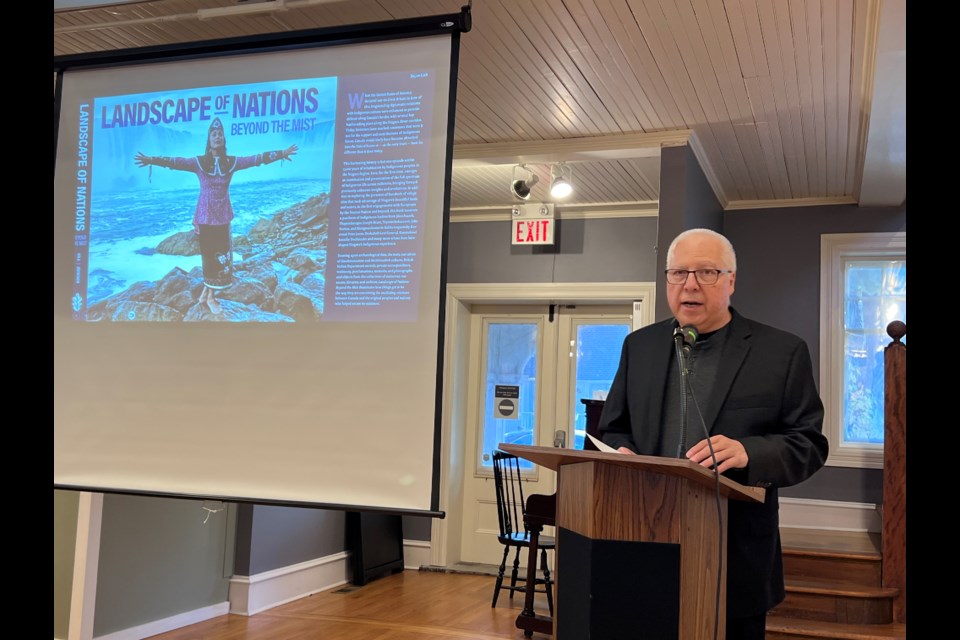A recently published book is, at its core, a history of Indigenous Peoples, but is also a “love story to the Niagara Region,” said co-editor Tim Johnson at a book launch held at the Niagara-on-the-Lake Museum last Saturday.
Landscape of Nations: Beyond the Mist features the work of 17 “scholars and knowledge holders,” said Johnson.
The book, “designed to be beautiful,” displays “phenomenal artwork” as well as the extraordinary photography of the region by Mark Zelinski, said Johnson, former associate director at the Smithsonian Institution’s National Museum of the American Indian. He is currently senior advisor for Heritage and Legacy at the Niagara Parks Commission and at Plenty Canada.
At the launch, Zelinski explained his photo of Brock’s Monument in the foreground of the mighty Niagara River, spread over two pages, was taken by a drone. He described the process of taking the photo, which included arriving at the site early to capture the mist rising from the river.
Niagara-on-the-Lake historian Ron Dale spoke to the large crowd assembled at the museum about his contributions to the book, which focuses on the first contact Indigenous Peoples had with the Europeans, and recounts how, about four hundred years ago, the Loyalists tried to convert Indigenous Peoples.
Richard Merritt, a NOTL resident with deep interest in researching and preserving Niagara’s heritage, contributed a few chapters, including one explaining the importance of the Indian Council House, which was located on the commons where currently a structure stands commemorating the site. The original Council House was burned by the Americans in the War of 1812, said Merritt, but was rebuilt after the war.
Merritt also talked about his chapter Indigenous Presence in early Niagara-on-the-Lake, and described how many prominent families had Indigenous connections, including Catharine Hamilton, after whom St. Catharines was named.
Tim Johnson’s chapter, Maid of the Mist and the Thunder Beings, tells the story of a despondent young woman who paddled her canoe over Niagara Falls, and the Thunder Beings, a group of spiritual elders who held a healing ceremony, empowering the woman to return to her village. The original artwork for this piece, by Indigenous artist Oren Lyons, is on display in the Journey Behind The Falls attraction in Niagara Falls.
Rick Hill, the other co-editor and a renowned educator of Indigenous cultures, histories and arts, currently serves as an Indigenous Innovations Specialist at Mohawk College. Hill submitted a chapter called Indigenous Vignettes, Reflections of The People.
Travis Hill and Jim Hill, unrelated, wrote about the flow of history and included a map of heritage locations on the Niagara River.
Jennifer Dockstader, executive director of the Fort Erie Native Friendship Centre, penned a chapter titled Indigenous Identity, Heritage and Legacy.
Karl Dockstader, Indigenous cultural advisor at Niagara College and One Dish One Mic podcaster, wrote the final chapter, A Cultural Conversation. He is also a “masterful digital artist,” said Johnson, and Dockstader’s interpretation of the Maid of the Mist wraps up the book.
Available for sale at the Niagara-on-the-Lake Museum, the 256-page book is published by the Niagara Parks Commission and Plenty Canada, an Indigenous-led organization committed to environmental protection.
Before book signing commenced, Johnson invited all to the Indigenous Veterans Day ceremony called Valour and Victory at Queenston’s Landscape of Nations, on Nov. 2, at 1 p.m. Parks Canada and the Historic Sites and Monuments Board of Canada will be unveiling a new plaque commemorating the historic significance of Teyoninhokarawen (John Norton). The ceremony will be offered in French, English and Mohawk.
